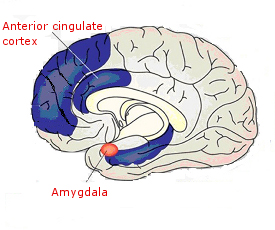Short explanation? Bigger right amygdala =
Post# of 65629
Short explanation?
Bigger right amygdala = chicken hawks threatening what they’re going to do to other countries, using other people’s kids to do it. And of course, pearl clutching posters ostensibly hiding from awwwwful language, boo hoo!
‘Rosetta Stone’ for understanding posts on this and other boards, and pretty much everything that is unfolding in our political system.
Some of you are watching confirmation of every point in these articles, in the Republican debate.
Seriously, I wonder if they have to mop up puddles of urine behind each podium after each Republican debate!
http://2012election.procon.org/files/1-2016-e...inal_2.jpg
Liberals have more tolerance to uncertainty (bigger anterior cingulate cortex), and conservatives have more sensitivity to fear (bigger right amygdala).

"In a large sample of young adults, we related self-reported political attitudes to gray matter volume using structural MRI [magnetic resonance imaging]. We found that greater liberalism was associated with increased gray matter volume in the anterior cingulate cortex, whereas greater conservatism was associated with increased volume of the right amygdala...
...[O]ur findings are consistent with the proposal that political orientation is associated with psychological processes for managing fear and uncertainty.
The amygdala has many functions, including fear processing. Individuals with a larger amygdala are more sensitive to fear, which, taken together with our findings, might suggest the testable hypothesis that individuals with larger amagdala are more inclined to integrate conservative views into their belief systems... our finding of an association between anterior cingulate cortex [ACC] may be linked with tolerance to uncertainty.
One of the functions of the anterior cingulate cortex is to monitor uncertainty and conflicts. Thus it is conceivable that individuals with a larger ACC have a higher capacity to tolerate uncertainty and conflicts, allowing them to accept more liberal views."
Conservatives Big on Fear, Brain Study Finds
Are people born conservative?
Posted Apr 19, 2011
Peering inside the brain with MRI scans, researchers at University College London found that self-described conservative students had a larger amygdala (link is external) than liberals. The amygdala is an almond-shaped structure deep in the brain that is active during states of fear and anxiety.
Liberals had more gray matter at least in the anterior cingulate cortex, a region of the brain that helps people cope with complexity.
The results are not that surprising as they fit in with conclusions from other studies. Just a year ago, researchers from Harvard and UCLA San Diego reported finding a "liberal" gene. This gene had a tiny effect, however, and worked only for adolescents having many friends. The results also mesh with psychological studies on conflict monitoring.
What It Means
There is a big unknown underlying these findings. Supposing that the size of one's amygdala really does increase the likelihood of being a conservative. Is the size of the amygdala determined at birth, or does it perhaps increase with frightening childhood experiences, such as authoritarian parenting and corporal punishment?
Similarly, one might ask whether the gray matter difference is affected by exposure to educational challenge, social diversity, or childhood cognitive enrichment.
The born versus acquired perspective on political attitudes is important to psychologists. After all, if political proclivities are fixed at birth in terms of brain anatomy, there is little hope of change.
Most of us would probably like to see a world in which political attitudes were less polarized, and more changeable, but that may be a pipe dream.
Meanwhile, the neuro-scientific fact of two very different political creatures helps clarify much of the political antics of modern democracies.
Most societies are divided into a party that wants change (the more liberal party) and one that is afraid of change (the conservatives). The liberal party is generally more intellectual and the conservative party is more anti-intellectual.
The conservative party is big on national defense and magnifies our perception of threat, whether of foreign aggressors, immigrants, terrorists, or invading ideologies like Communism. To a conservative, the world really is a frightening place.
Given that their brains are so different, it is hardly surprising that liberals and conservatives should spend so much time talking across each other and never achieving real dialog or consensus.
As scientists we hope that these results are replicated because they shed so much light on political behavior. As citizens, we would prefer if politicians were not divided into such different categories of political animal.
If everyone was born with the same brain potential to acquire either conservative, or liberal, views, then we could be more optimistic about prospects for political communication and consensus-building. If voters were of like brain, perhaps they could be of like mind.
 (1)
(1) (0)
(0)